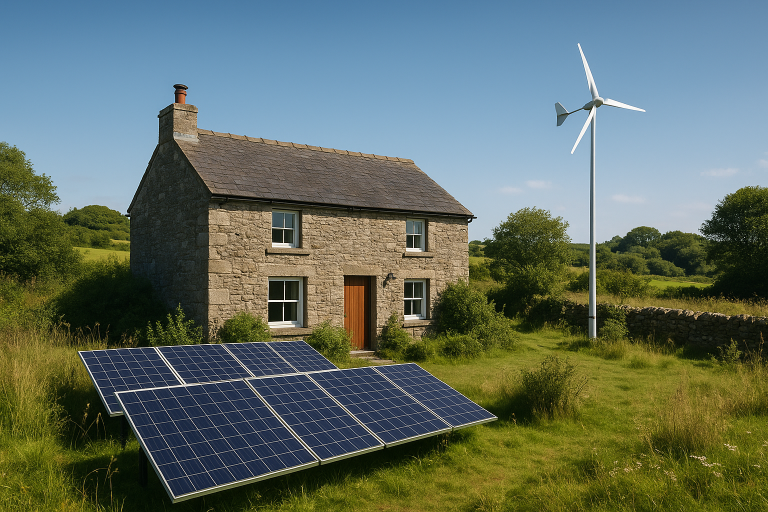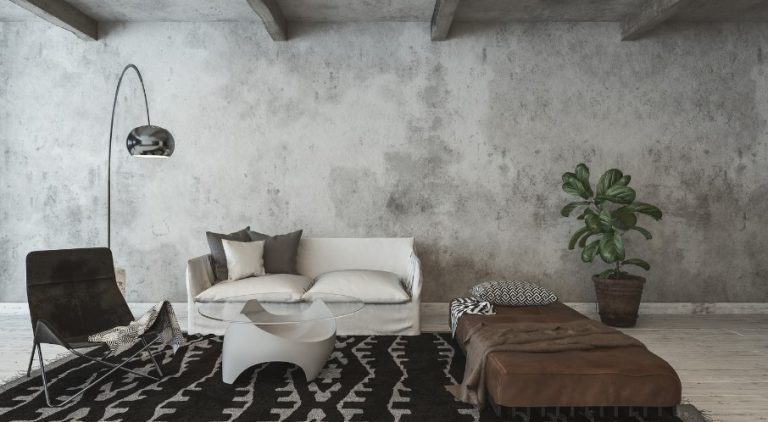Summer temperatures in the UK have become increasingly unpredictable, with heatwaves becoming more frequent and intense. While warm weather is typically welcomed, prolonged high temperatures can lead to uncomfortable and even dangerous indoor conditions.
Many UK homes, especially older or poorly ventilated buildings, are not designed to handle extreme heat. This guide provides practical, expert-backed solutions to help keep homes cool during the summer months in the UK climate.
Why Do UK Homes Overheat During Summer?
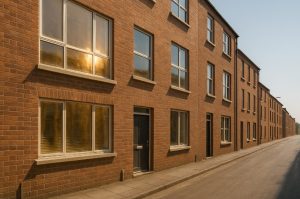
UK homes are predominantly built to retain heat rather than release it, due to historically colder weather. However, the rise in summer temperatures and frequency of heatwaves has made overheating a significant issue in domestic properties.
Certain property features make homes more prone to overheating:
- Flats on the top floor, where heat naturally rises
- Homes with windows on only one side, limiting cross ventilation
- Large south or west-facing windows that lack shading
- Properties in built-up urban areas with little greenery, known as the urban heat island effect
- Highly insulated or airtight homes that trap heat
- Residences with inefficient hot water systems that release excess heat
- Buildings where windows cannot be fully opened due to safety restrictions
Homes affected by one or more of these conditions can quickly become uncomfortably warm, especially when combined with the UK’s increasingly warm summers.
Who Is Most at Risk from a Hot Home in the UK?
Some individuals are particularly vulnerable to indoor heat and require extra care and planning during warmer months. People at higher risk include:
- Adults aged 65 and older
- Children aged five and under
- Individuals with long-term illnesses, particularly respiratory or cardiovascular conditions
- Pregnant women
- Those who live alone or experience social isolation
- People taking medications that impair the body’s ability to regulate temperature
- Individuals working from home or indoors throughout the day
Health risks associated with prolonged exposure to indoor heat include dehydration, heat exhaustion, and in severe cases, heatstroke or worsening of chronic health conditions.
What Passive Cooling Techniques Work Best in the UK?
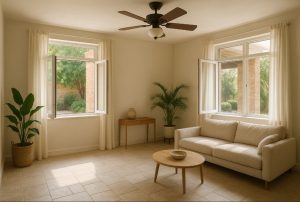
Passive cooling refers to using non-mechanical, low-energy methods to reduce indoor temperatures. In the UK, where heatwaves are increasing but homes are generally not built for warm climates, passive cooling is essential for maintaining comfort during the summer months.
These techniques are especially effective in reducing overheating without relying on expensive systems like air conditioning.
Natural Ventilation: Letting Air Flow Work for You
Natural ventilation is one of the most accessible and cost-effective forms of passive cooling. By strategically opening and closing windows and doors, homeowners can encourage airflow through the property and remove warm, stagnant air.
Key methods of natural ventilation:
- Cross-ventilation: Opening windows on opposite sides of a room or home helps create a breeze. This technique is especially effective in semi-detached or detached houses.
- Stack ventilation: Utilising the principle that hot air rises, this involves opening high-level windows (like skylights or upstairs windows) in combination with lower openings to draw warm air upwards and out.
- Night purging: Leaving windows open overnight allows cool evening air to flush out the heat accumulated during the day, especially effective after a hot afternoon.
Ventilation should always be done with security and safety in mind, especially in ground-floor flats or when children are present.
Window Management: Controlling Solar Gains
Windows are a major source of heat entry during the summer, particularly those facing east, south, or west. Managing them correctly is vital in passive cooling.
Strategies for effective window cooling:
- Keep windows closed during the hottest parts of the day to prevent warm air from entering.
- Open windows early in the morning or late evening when temperatures are cooler.
- Apply solar control film or reflective film to windows to reduce direct heat from sunlight.
- Install external shading devices like shutters, awnings, or brise-soleil to block sunlight before it enters the home.
Managing windows based on outdoor conditions can significantly reduce internal temperatures without mechanical intervention.
Thermal Mass: Using Building Materials to Regulate Heat
Thermal mass refers to the ability of materials to absorb, store, and release heat. Homes that incorporate materials with high thermal mass can help even out daily temperature swings by storing heat during the day and releasing it at night when temperatures fall.
Ideal materials for thermal mass:
- Concrete and stone floors or walls
- Brick and masonry
- Tiled surfaces, especially in kitchens and bathrooms
Placing thermal mass where it can be exposed to internal air flow enhances its effectiveness. In the UK, many traditional homes already include these materials, making them naturally equipped for thermal moderation with the right ventilation.
Insulation for Summer: Not Just for Winter
Insulation is commonly associated with retaining heat in winter, but it also works to keep heat out in summer. Proper insulation prevents external heat from entering the home during hot days and helps maintain a stable internal temperature.
Summer benefits of insulation:
- Slows the rate of heat gain from the roof and walls
- Keeps loft spaces cooler, reducing upstairs overheating
- Enhances the performance of passive cooling strategies like ventilation
Insulating the roof and upper floors is especially important for top-floor flats and loft conversions where heat naturally accumulates.
Shading and Blinds: Blocking the Sun Before It Heats the Space
Preventing sunlight from entering a room is far more effective than trying to cool it down once the heat has accumulated.
Types of shading systems:
- Internal blinds: Roller, Venetian, or blackout blinds can reflect and block light when closed
- Curtains: Thermal or reflective-lined curtains can help reduce solar heat gain
- External shading: Devices such as canopies, pergolas, and external roller blinds offer greater effectiveness than internal shading alone
Positioning shading solutions particularly on east-, south-, and west-facing windows will yield the best results. Shading also helps protect furniture and flooring from UV damage.
Landscaping and External Features: Cooling Through Design
Outdoor areas and surrounding environments play a role in regulating internal temperatures. Thoughtful landscaping can shade walls and windows while reducing the reflective heat from hard surfaces.
Cooling landscaping features:
- Planting trees or tall shrubs to shade walls and windows during peak sunlight hours
- Growing vines or climbers on trellises near windows to act as natural sun filters
- Using permeable surfaces and greenery instead of concrete paths or patios to reduce surface temperatures
This approach not only cools the home but also contributes to greater biodiversity and wellbeing.
Furniture and Interior Design Considerations
How a home is furnished and decorated can also influence its temperature. Overstuffed or heavy materials can trap heat, while lighter materials promote air movement.
Design adjustments for cooler interiors:
- Use breathable fabrics like cotton or linen for upholstery and bedding
- Choose light-coloured décor and furniture to reflect heat
- Keep furniture away from windows to prevent blocking airflow
- Avoid rugs or carpets in favour of tile or stone flooring during summer
These subtle changes can make a noticeable difference in overall indoor comfort.
When Should Passive Cooling Be Prioritised?
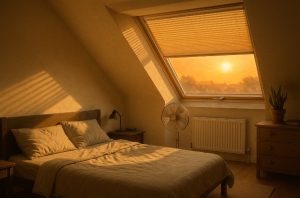
Passive cooling is most effective in homes without built-in air conditioning and in regions where summer temperatures fluctuate. It is especially useful:
- During UK heatwaves, when temperatures exceed 25°C consistently
- In homes with elderly or vulnerable occupants
- In properties where retrofitting air conditioning is not feasible or cost-effective
- As part of sustainable living goals to reduce energy consumption and environmental impact
Passive methods often work best when used in combination, such as shading windows while encouraging night-time ventilation. Planning and implementing these techniques ahead of peak summer months ensures a more effective and comfortable outcome.
How Can You Prepare Your Home for Hot Weather?
Preparing a home before the hot weather arrives is one of the most effective ways to manage summer temperatures indoors. Proactive steps can help prevent overheating and reduce reliance on emergency measures during heatwaves.
Important preparations include:
- Installing internal blinds or curtains to prevent direct sunlight from heating rooms
- Investing in external solutions such as shutters or awnings for windows that face the sun
- Checking mechanical ventilation systems and setting them to summer mode if available
- Verifying that fridges and freezers are working efficiently by monitoring food temperatures
- Ensuring that medicine storage complies with manufacturer temperature guidelines
- Discussing potential overheating risks with insulation or window installers when upgrading the home
- Growing leafy plants outside south-facing windows to block sunlight and improve shading
Incorporating these measures can lead to a more comfortable indoor environment throughout the summer months.
What Immediate Actions Can Reduce Heat Indoors?
When high temperatures are already affecting a home, several practical strategies can help reduce discomfort and keep the living space safe.
Quick-response measures include:
- Shading or covering windows using reflective curtains or blinds during daylight hours
- Opening windows during cooler hours of the day, typically early morning and late evening
- Turning off lights and electrical appliances that are not in use to reduce heat generation
- Avoiding the use of ovens or stoves during peak heat times
- Relocating sleeping areas to cooler parts of the home, such as lower floors
- Using electric fans when indoor air temperatures are below 35°C and aiming them indirectly to avoid dehydration
These actions, while simple, can make a meaningful difference in maintaining comfort without major home modifications.
How Can Plants and Greenery Help Keep Homes Cool?

Plants offer both functional and aesthetic benefits in helping to regulate indoor and outdoor temperatures. Properly placed greenery can block sunlight, improve air circulation, and raise humidity levels in dry, hot indoor environments.
Outdoor plant strategies:
- Tall shrubs, climbing plants, and trellises can provide shade for sun-facing windows and walls
- Ground cover or grass instead of concrete can reduce heat retention around the home
- Trees planted strategically can offer natural shade and cooling through evapotranspiration
Indoor plant suggestions:
- Peace lilies and snake plants release moisture into the air, improving indoor humidity and reducing dryness
- Aloe vera and English ivy help cool smaller spaces like bathrooms or window ledges
- Positioning multiple plants near windows or in warm rooms increases overall cooling effect
The use of plants as a passive cooling method is both environmentally friendly and cost-effective.
What Are Energy-Efficient Cooling Alternatives in the UK?
For households that wish to avoid air conditioning, which is uncommon and often inefficient in the UK climate, several alternatives provide efficient cooling while conserving energy.
Common energy-saving cooling tools and techniques:
- Solar-control or reflective window films that reduce solar gain
- Use of low-emission lighting, such as LED bulbs, to limit internal heat production
- Smart thermostats or temperature sensors to monitor and optimise indoor comfort
- Portable evaporative air coolers that use water evaporation instead of refrigerant gas
The following table outlines a comparison of popular energy-efficient cooling methods:
| Cooling Method | Energy Usage | Ideal Conditions | Estimated Cost |
| Reflective Window Film | Very Low | Homes with direct sun exposure | Low |
| Portable Evaporative Cooler | Moderate | Dry indoor environments | Medium |
| Electric Fan | Low | Below 35°C indoor temp | Low |
| Smart Thermostat | Very Low | Homes with multiple zones | Medium to High |
| External Shutters or Awnings | None | South-facing or large windows | Medium to High |
By choosing the most appropriate option for their living space, UK residents can maintain comfort without overloading their energy consumption or monthly bills.
How Can Tenants and Homeowners Get Support to Stay Cool?
Different housing situations provide access to varying resources, so understanding where to seek assistance is essential.
Support options based on housing type:
| Housing Type | Support Available |
| Social Housing | Local councils, social housing providers, Home Improvement Agencies |
| Private Renting | Local councils for inspections, advice from Citizens Advice, landlord negotiation |
| Home Ownership | Accredited home improvement services, local council retrofit funding |
Social housing residents can reach out to organisations like First Stop Care Advice or contact their local authority for guidance. Private renters may consult Citizens Advice or their landlord regarding installing cooling features like blinds or films. Homeowners can benefit from retrofit schemes aimed at improving insulation and ventilation systems.
In all cases, it is beneficial to prepare in advance and keep track of national heat-health alerts through GOV.UK and the NHS.
How Can You Stay Cool Without Using Air Conditioning?
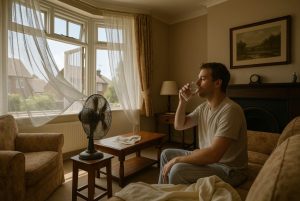
Since most UK homes are not equipped with built-in air conditioning, residents often rely on lifestyle adaptations and small devices to stay comfortable.
Effective alternatives include:
- Placing wet cloths or cool packs on wrists and ankles to lower body temperature
- Wearing breathable cotton or linen clothing
- Sleeping with lightweight sheets or moisture-wicking materials
- Using a spray bottle filled with cold water to mist the air in warmer rooms
- Visiting public places like supermarkets or libraries during the hottest times of the day
Maintaining hydration and taking regular breaks from direct sunlight are also key steps in staying safe during UK heatwaves. These practices require little to no energy and can be implemented quickly in any living situation.
Conclusion
As the UK experiences increasingly hotter summers, keeping homes cool is no longer just a comfort but a health and safety priority. Understanding how homes overheat, identifying at-risk individuals, and applying passive cooling and energy-efficient methods are vital.
Whether you’re a tenant, homeowner, or landlord, preparation and simple day-to-day practices can make a significant difference in indoor comfort during the warmer months.
By using government advice and adapting your home accordingly, you can stay safe, cool, and well-prepared for the UK’s rising summer temperatures.
Frequently Asked Questions
What are the best home modifications for reducing heat indoors?
Installing reflective window films, adding external shutters, and improving roof ventilation can significantly reduce heat gain in UK homes.
Can opening windows all day help keep the house cool?
Not necessarily. It’s more effective to open windows during the cooler hours of the day (early morning and late evening) to create cross ventilation.
Do fans work when it’s very hot?
Fans are effective below 35°C. Above this, they may circulate hot air and increase dehydration risk. Use them strategically and indirectly.
Is it cooler to sleep downstairs during a heatwave?
Yes. Heat rises, so ground-floor or basement rooms tend to stay cooler. Moving sleeping arrangements during extreme heat can improve comfort.
Can landlords refuse to make cooling-related upgrades?
Landlords have a duty to provide safe and habitable living conditions. Tenants can contact the local council if landlords are unresponsive to reasonable heat mitigation requests.
Are indoor plants really effective in cooling homes?
Certain plants help by releasing moisture into the air, improving humidity and reducing indoor temperature slightly, especially in closed spaces.
What UK government support exists for cooling homes?
Support may be available through local councils, Home Improvement Agencies, and other energy-efficiency funding schemes. Citizens can also seek advice from NHS and Gov.uk resources.





